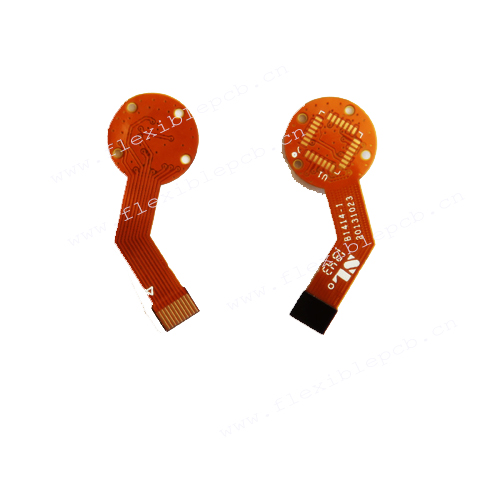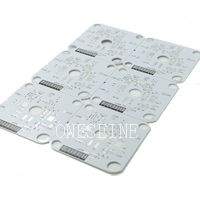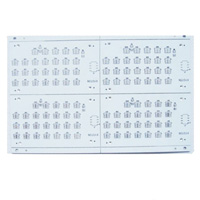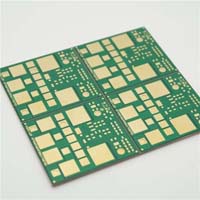Printed Circuit Boards
One layer ENIG flexible printed circuit board manufacturers
- flexible pcb
- 1 layer
- flex pcb manufacturing
- rigid flex circuit boards
- Product description: flex circuit board manufacturers semi flex pcb flex pcb design flex printed circuit rigid flex pcb fabrication jlcpcb flex pcb flexible pcb fabrication coverlay pcb flex circuit design rigid
One layer ENIG flexible printed circuit board manufacturers
PCB layer:1
PCB material:Polymide
Surface finish:ENIG
Board size:8*3CM
Board thickness:0.1MM
Flexible circuit boards, also known as "soft boards," are printed circuits made of flexible insulating substrates. Flexible circuits provide excellent electrical performance, which can meet the design needs of smaller and higher density installations, as well as help reduce assembly processes and enhance reliability. Flexible circuit boards are the only solution to meet the miniaturization and mobility requirements of electronic products. It can be freely bent, wound, and folded, and can withstand millions of dynamic bends without damaging the wires. It can be arranged according to spatial layout requirements, and can move and expand freely in three-dimensional space, achieving the integration of component assembly and wire connection; Flexible circuit boards can greatly reduce the volume and weight of electronic products, making them suitable for the development of electronic products towards high-density, miniaturization, and high reliability.
Cost Effective Flex & Rigid-Flex PCBs
When it comes to our flex and rigid-flex products, we offer a variety of cost effective solutions and capabilities that include single or double sided circuitry to higher technology multilayer designs up to 20 layers. From selecting the best functional configuration, to choosing the proper connectors or components, we will help you meet or exceed all your applications requirements.
Our flex and rigid-flex PCBs are manufactured for various applications in the medical, military, aerospace, and portable devices industries.
Our engineering team can assist you from early design stages of your application all the way to end product production for all your flex and rigid-flex circuit needs.
Flexible PCB Design Considerations
Proper design is crucial for manufacturing reliable, high-performing flex PCBs. Designers must account for the dynamic nature of flex circuits and make considerations for:
Bend Radius – The minimum bend radius determines the flexibility and durability. Inside bend radii down to 0.1mm can be achieved with optimal materials and stackup.
Board Stiffness – Polyimide films provide good flexural endurance but also dimensional stability. Selective stiffening elements like cover layers are used when needed.
Thermal Management – Large copper planes dissipate heat efficiently. But flexing actions require thermal mitigation techniques like thermal reliefs.
High-Frequency Layout – Controlled impedance traces, ground planes, and vias enable flex PCBs to operate at high frequencies for RF and digital signals.
Component Selection – Low-profile SMT components withstand flexing and minimize thickness. Avoid rigid connectors, opting for flex-tail or ribbon cable connections.
Attachment Methods – Soldering, conductive epoxy, and mechanical fastening attach components reliably. Adhesive selection is also critical.
At ONESEINE PCB, our engineering team provides flex PCB design reviews and recommendations to identify opportunities for optimization. We have experience designing flex circuits for dynamic applications across industries.
By partnering with us early in the design process, we can help assess manufacturability, troubleshoot any issues with the planned construction, and ensure your flex PCB design is optimized for cost-effective fabrication and assembly.
Flexible PCB Assembly Techniques
Assembly of components onto flex PCBs requires specialized techniques compared to standard rigid PCB assembly. ONESEINE PCB has developed proven assembly processes to mount components onto flex circuits reliably.
SMT assembly is suitable for lower component counts, allowing pick-and-place and reflow soldering of chip components. For higher densities, manual assembly may be required.
Component attachment methods include:
Solder joints – For heat-resistant components. Care is needed to avoid base film damage.
Conductive epoxy – Provides strong mechanical bonds with electrical connection.
Mechanical fasteners – Standoffs, screws, and clamps provide solid mounting.
Pressure-sensitive adhesives – Adhere components while allowing rework/repair.
We select adhesives optimized for flexibility, peel strength, tear resistance, and operating temperatures. Adhesive curing methods include heat, pressure, ultrasonic energy, and humidity.
Flex PCB rework and repair present challenges due to the sensitivity of polyimide films. We utilize specialized systems and processes for component removal and replacement without circuit damage.
Our experienced PCB assembly technicians are trained on the unique requirements of flex PCB assembly. We’ve optimized our assembly processes for high yields, maximum uptime, and fast turnaround.
By leveraging our flex PCB assembly expertise, customers can accelerate their hardware development schedules and move quickly from PCB prototyping to mass production. We’re ready to discuss your specific application requirements and determine the optimal assembly process.
Flexible PCB Fabrication Process
Flex PCBs require specialized materials and processes compared to standard rigid PCB boards. ONESEINE PCB utilizes cutting-edge fabrication techniques to produce high-quality, reliable flex circuits.
Polyimide is the most common base material used in flex PCB fabrication. The high heat resistance, chemical stability, and mechanical flexibility of polyimide films like DuPont’s Kapton make them ideal substrates. We also use flexible PET films for certain applications.
The circuitry layers are constructed using rolled annealed copper laminated to the base film. Photolithographic patterning techniques are used to etch the copper and generate trace geometries and spaces. Flex PCBs are typically single-layer or multilayer with 2 to 12 metal layers separated by adhesive dielectric films.
Our flex PCB manufacturing capabilities support sophisticated flex stackups. We produce double-sided flex using plated-through holes and microvias for interlayer connections. For multilayer flex, laser drilling forms high-density vias with diameters down to 50μm.
Compared to rigid PCB boards, flex PCB fabrication offers benefits like:
Thinner overall construction for compact, lightweight circuits
Dynamic flexural capability for movable/shape-changing electronics
Improved high-frequency signal integrity at bends
Enhanced heat dissipation with heat-spreader copper layers
Fine line/space traces and spacing for high interconnect density
We utilize AOI and electrical testing throughout the fabrication process to ensure quality standards are met. Coupon samples are also tested for coating thickness, adhesion, solderability, and other performance metrics.
Categories
Latest News
Contact Us
Contact: Ms Tracy
Phone:
Tel:
Add: BludingA,Shixiaganglian Industrial Park,Shajing,Baoan,Shenzhen,China




 Tracy
Tracy